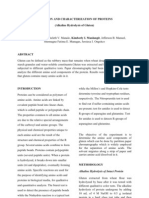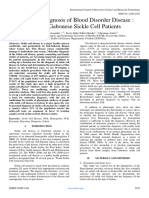Cytogenetics Transes Topic 16
Cytogenetics Transes Topic 16
Uploaded by
Dianne NolascoCopyright:
Available Formats
Cytogenetics Transes Topic 16
Cytogenetics Transes Topic 16
Uploaded by
Dianne NolascoCopyright
Available Formats
Share this document
Did you find this document useful?
Is this content inappropriate?
Copyright:
Available Formats
Cytogenetics Transes Topic 16
Cytogenetics Transes Topic 16
Uploaded by
Dianne NolascoCopyright:
Available Formats
1 - BSMLS
CYTOGENETICS
TERM
MLS 102
BREAK
CLASS
LECTURE & LABORATORY NOTES
School: Lyceum of the Philippines University – Batangas Academic Year: 2020 - 2021
Program: Bachelor of Science in Medical Laboratory Science Professor: Deignielle Bert Arellano
S(Source: Powerpoint Presentation)
LESSON 16: GENE THERAPY
THE BEGINNING…
In the 1980s, scientists began to look into
gene therapy.
They would insert human genes
into a bacterial cell.
GENES Then the bacterial cell would
transcribe and translate the
Are carried on a chromosome information into a protein.
The basic units of heredity Then they would introduce the
When altered, it causes dysfunction of a protein into human cells.
protein
When there is mutation in the geen, then it THE FIRST CASE
will change the codon, which will change the
amino acid called for, changing the The first gene therapy was performed on
conformation of the protein and its function September 14, 1990.
Genetic disorder result from mutations in Ashanti DeSilva was treated for
the genome SCID. (Severe combined
immunodeficiency)
WHAT IS GENE THERAPY? Doctors removed her white blood
cells, inserted the missing gene
It is a technique for correcting defective into the WBC, and then put them
genes that are responsible for disease back into her blood stream.
development. This strengthened her immune
There are four approaches: system.
1. A normal gene is inserted to Only worked for a few months
compensate for a nonfunctional
gene. HOW IT WORKS
2. An abnormal gene is traded for a
normal gene. A vector delivers the therapeutic gene
3. An abnormal gene is repaired into a patient’s target cell.
through selective reverse mutation. The target cells become infected with the
4. Change the regulation of gene pairs. viral vector.
The vector’s genetic material is inserted
into the target cell.
Functional proteins are created from
the therapeutic gene causing the cell
to return to a normal state.
Lyceum of the Philippines University – Batangas BSMLS 1C – Basilan, VNC 1
MLS 102 - CYTOGENETICS
VIRUSES ADENO-ASSOCIATED VIRUSES
Replicate by inserting their DNA into a host Small, single-stranded DNA that inserts
cell genetic material at a specific point on
Gene therapy can use this to insert chromosome 19
genes that encode for a desired From Parvovirus family- causes no known
protein to create the desired trait. disease and does not trigger patient
Four different types: immune response.
1. Retrovirus Low information capacity
2. Adenovirus Gene is always “on” so the protein is
3. Adeno-associated virus always being expressed, possibly even in
4. Herpes simplex virus instances when it isn’t needed.
Example: Hemophilia treatments - a gene-
RETROVIRUSES carrying vector could be injected into a
muscle, prompting the muscle cells to
Creates double stranded DNA copies from produce Factor IX and thus, prevent
RNA bleeding.
genome Study by Wilson and Kathy High
The retrovirus goes through reverse (University of Pennsylvania)
transcription using reverse transcriptase Patients have not needed Factor IX
and RNA. injections for more than a year.
The double stranded viral genome
integrates into the human genome using HERPES SIMPLEX VIRUSES
integrase.
Integrase inserts the gene anywhere Double-stranded DNA viruses infect
because it has no specific site. neurons
May cause insertional mutagenesis Examples: Herpes simplex virus type 1
One gene disrupts
another gene’s code
(disrupted cell division
causes cancer from
uncontrolled cell division).
Vectors used are derived from the
human immunodeficiency virus (HIV) and
are being evaluated for safety.
ADENOVIRUSES
Double – stranded DNA genome that NON-VIRAL OPTIONS
causes respiratory, intestinal, and eye
infections in hums Direct introduction of therapeutic DNA
The inserted DNA is NOT incorporated into o Only with certain tissues
the genome. o Required a lot of DNA
Not replicated; has to be inserted when Creation of artificial lipid sphere with
more cells divide aqueous core, liposome
Example: Common Cold o Carries therapeutic DNA through
membrane
Lyceum of the Philippines University – Batangas BSMLS 1C – Basilan, VNC 2
MLS 102 - CYTOGENETICS
DEATH was triggered by severe immune
response to adenovirus carrier.
January 2003 – halt to using retrovirus
vectors in blood stem cells because
children developed leukemia – like
condition after successful treatment for X –
linked severe combined immunodeficiency
disease.
NON-VIRAL OPTIONS
Chemically linking DNA to molecule
that will bind to special cell receptors
DNA is engulfed by cell membrane.
Less effective
Trying to introduce a 47th
chromosome
Exist alongside the 46 others
Could carry a lot of information
Alipogene tiparvovec, sold under the brand
name Glybera, is a gene therapy treatment
designed to reverse lipoprotein lipase
deficiency (LPLD), a rare inherited disorder which
can cause severe pancreatitis. It was
recommended for approval by the European
Medicines Agency in July 2012 and approved by
the European Commission in November of the
same year. It was the first marketing
authorization for a gene therapy treatment in
either Europe or the United States.
PROBLEMS WITH GENE THERAPY
Short Lived
Hard to rapidly integrate therapeutic
DNA into genome and rapid
CURRENT STATUS cell division prevents gene
therapy from long time
Slow approval Multiple rounds of therapy is
Reasons: needed.
In 1999, 18 – year – old, Jesse Gelsinger Immune Response
died from multiple organ failure 4 days after New things introduced leads
treatment for ornithine transcarboxylase to immune response.
deficiency. Increased response when a repeat
offender enters
Lyceum of the Philippines University – Batangas BSMLS 1C – Basilan, VNC 3
MLS 102 - CYTOGENETICS
Viral Vectors In these patients, peripheral T cells
Patient could have toxic, immune, were transduced with a vector bearing
inflammatory response. the gene for adenosine deaminase.
May cause disease once inside The experiment was extremely
Multigene Disorders labor intensive, because mature
Heart disease, peripheral-blood T cells were modified
hypertension, Alzheimer’s, arthritis rather than stem cells, and the procedure
and diabetes are hard to treat therefore had to be repeated many
because you need to introduce times to achieve success.
more than one gene.
May induce a tumor if integrated in a SUCCESSFUL ONE YEAR GENE THERAPY
tumor suppressor gene because of TRIAL FOR PARKINSON'S DISEASE
insertional mutagenesis
UNSUCCESSFUL GENE THERAPIES Neurologix, a biotech company
announced that they have successfully
Jesse Gelsinger, a gene therapy patient completed its landmark Phase I trial of
who lacked ornithine transcarbamylase gene therapy for Parkinson's Disease.
(OTC) activity, died in 1999. This was a 12 patient study with four
Within hours after doctors shot the normal patients in each of three dose
OTC gene attached to a therapeutic escalating cohorts. All procedures were
virus into his liver, Jesse developed a high performed under local anesthesia and
fever. all 12 patients were discharged from
His immune system began raging out of the hospital within 48 hours of the
control, his blood began clotting, procedure, and followed for 12 months.
ammonia levels climbed, his liver Primary outcomes of the study design,
hemorrhaged and a flood of white blood safety and tolerability, were successfully
cells shut down his lungs. met. There were no adverse events
One problem with gene therapy is that one reported relating to the treatment.
does not have control over where the gene
will be inserted into the genome. PARKINSON'S DISEASE
The location of a gene in the genome is of
importance for the degree of The gene transfer procedure utilized the
expression of the gene and for the AAV (adeno-associated virus) vector,
regulation of the gene (the so-called a virus that has been used safely in
"position effect"), and thus the gene a variety of clinical gene therapy trials, and
regulatory aspects are always the vehicle that will be used in all of the
uncertain after gene therapy. company’s first generation products,
including epilepsy and Huntington’s
SUCCESSFUL GENE THERAPY FOR SEVERE disease.
COMBINE IMMUNODEFICIENCY In its Parkinson’s disease trial, Neurologix
used its gene transfer technology.
Infants with SCID are unable to mount
an adaptive immune response, because RECENT DEVELOPMENTS
they have a profound deficiency of
lymphocytes. Genes get into brain using liposomes
Severe combined immunodeficiency coated in polymer called polyethylene
is inherited as an X-linked recessive glycol.
disease, which for all practical purposes o Potential treatment for Parkinson’s
affects only boys. disease
In the other half of the patients with
severe combined immunodeficiency, the RNA interference or gene silencing to treat
inheritance is autosomal recessive — Huntington’s
and there are several abnormalities siRNAs used to degrade RNA of particular
in the immune system when the sequence.
defective gene is encoded on an Abnormal protein will not be produced.
autosome. Creation of tiny liposomes that can carry
therapeutic DNA through pores of nuclear
SEVERE COMBINE IMMUNODEFICIENCY membrane
Sickle cell disease successfully treated in
A previous attempt at gene therapy mice
for immunodeficiency was successful in
children with SCID due to a deficiency of
adenosine deaminase.
Lyceum of the Philippines University – Batangas BSMLS 1C – Basilan, VNC 4
MLS 102 - CYTOGENETICS
GENE EDITING
Would you want to have designer babies?
Lyceum of the Philippines University – Batangas BSMLS 1C – Basilan, VNC 5
You might also like
- Health ReviewerDocument3 pagesHealth ReviewerAlyah Jannah HiñolaNo ratings yet
- Introduction To Immunology 1: Chapter 16 & 17 of Tortora PG 465 - 517Document42 pagesIntroduction To Immunology 1: Chapter 16 & 17 of Tortora PG 465 - 517ATIRAH100% (1)
- Trans Clinical Chemistry Lec4Document10 pagesTrans Clinical Chemistry Lec4Kelvin CafirmaNo ratings yet
- Blood Typing Activity For Lab Practical 2Document11 pagesBlood Typing Activity For Lab Practical 2Liliana PerezNo ratings yet
- See Judge Act RelDocument5 pagesSee Judge Act RelthiccdoieeNo ratings yet
- DLL Science 8-4thQ-4Document5 pagesDLL Science 8-4thQ-4anon_298904132100% (5)
- Chapter 1: Evolution, The Themes of Biology, and Scientific InquiryDocument8 pagesChapter 1: Evolution, The Themes of Biology, and Scientific InquiryDan JohnsonNo ratings yet
- Articular System and JointsDocument9 pagesArticular System and JointsjsdlzjNo ratings yet
- Genetics: Heredity - The Natural Process by WhichDocument2 pagesGenetics: Heredity - The Natural Process by WhichDanNo ratings yet
- CPH Laboratory Exam/Project: Non-Communicable Diseases OR NutritionDocument2 pagesCPH Laboratory Exam/Project: Non-Communicable Diseases OR NutritionteuuuuNo ratings yet
- Introduction 2 PDFDocument178 pagesIntroduction 2 PDFSilent StarNo ratings yet
- PMLS Lec NotesDocument12 pagesPMLS Lec NotesBianca GeagoniaNo ratings yet
- Bacte Lec - Prelim ExamDocument84 pagesBacte Lec - Prelim ExamDanielle Anne LambanNo ratings yet
- BSC 100 Midterm Questions For Oral ExamDocument20 pagesBSC 100 Midterm Questions For Oral ExamNovochino CastilloNo ratings yet
- 19) Integrating Cells Into TissuesDocument37 pages19) Integrating Cells Into TissuesRNo ratings yet
- CPH Prefinal CHAPTER 5 Control and Prevention of Communicable DiseasesDocument79 pagesCPH Prefinal CHAPTER 5 Control and Prevention of Communicable DiseasesKristelle Marie Enanoria BardonNo ratings yet
- Chap 01Document35 pagesChap 01Agita RakaNo ratings yet
- Anabolic Pathways Lead To The Synthesis of More Complex Compounds FromDocument10 pagesAnabolic Pathways Lead To The Synthesis of More Complex Compounds FromnavneetNo ratings yet
- Different Division of ZoologyDocument2 pagesDifferent Division of ZoologyEiann Jasper Longcayana100% (1)
- Oro. M4 L2 Task 2 R. Questions - MicrolabDocument5 pagesOro. M4 L2 Task 2 R. Questions - MicrolabCharlou OroNo ratings yet
- 6 Ra 1517Document56 pages6 Ra 1517Jay Andrea Vea Dayuday-IsraelNo ratings yet
- 1 - Biochemistry of CancerDocument18 pages1 - Biochemistry of CancerJoo Se HyukNo ratings yet
- Examples of Community PartnersDocument3 pagesExamples of Community PartnersTERESA OSIALNo ratings yet
- Lesson 9 - Hospital Information SystemDocument3 pagesLesson 9 - Hospital Information Systemleanne decrepitoNo ratings yet
- BiochemDocument5 pagesBiochemHarvey Mher RarangNo ratings yet
- Histology - Lesson 1 - IntroDocument5 pagesHistology - Lesson 1 - IntroAngelina AquinoNo ratings yet
- His Lab AnswerDocument1 pageHis Lab AnswerKesney Ramirez100% (1)
- Lecture Notes in Medical Technology - Lecture #11 - EnzymologyDocument22 pagesLecture Notes in Medical Technology - Lecture #11 - EnzymologyKat JornadalNo ratings yet
- Zinc Sulfide Topical Suspension, USP, Lotio Alba, Lotio Sulfurata Zinc SulphideDocument2 pagesZinc Sulfide Topical Suspension, USP, Lotio Alba, Lotio Sulfurata Zinc SulphideJoanna Carla Marmonejo Estorninos-Walker100% (1)
- BIOCHEM-Carbohydrate Metabolism 2-Glycogenolysis GlycogenesisDocument8 pagesBIOCHEM-Carbohydrate Metabolism 2-Glycogenolysis GlycogenesisStd DlshsiNo ratings yet
- CELL AnatomyDocument8 pagesCELL Anatomyaryam aliNo ratings yet
- Microbiology CHapter 1Document66 pagesMicrobiology CHapter 1cj barias100% (4)
- Domingo, Joevani T. (Laboratory Manuals)Document141 pagesDomingo, Joevani T. (Laboratory Manuals)Joevani DomingoNo ratings yet
- Name: Iniego, Armando M. JR Date: August 26, 2021 Course&Year: Bsit 4ADocument2 pagesName: Iniego, Armando M. JR Date: August 26, 2021 Course&Year: Bsit 4AOCCArmando IniegoNo ratings yet
- Fats or Lipids-Wps OfficeDocument7 pagesFats or Lipids-Wps OfficeDeodel B. De GuzmanNo ratings yet
- PMLS2 - Familiarization in PhleboDocument3 pagesPMLS2 - Familiarization in PhleboCorinne Bautista RenivaNo ratings yet
- CHAPTER 3 - The Cellular Level of OrganizationDocument82 pagesCHAPTER 3 - The Cellular Level of OrganizationMarin Jr., Reynaldo J.No ratings yet
- Circulatory System TransesDocument10 pagesCirculatory System TransesDeus De CastroNo ratings yet
- Biochemistry Lecture 15 Biological Membranes - 1Document27 pagesBiochemistry Lecture 15 Biological Membranes - 1Professor Rakesh Sharma Biochemistry Lectures100% (1)
- CPH Lab - Prelim TransesDocument4 pagesCPH Lab - Prelim TransesLOUISSE ANNE MONIQUE L. CAYLONo ratings yet
- Lesson 1: Community HealthDocument7 pagesLesson 1: Community HealthBianca GeagoniaNo ratings yet
- Biochemistry Lecture 1: Ma. Cristina F. T DimaculanganDocument61 pagesBiochemistry Lecture 1: Ma. Cristina F. T DimaculanganAlthea ValenzuelaNo ratings yet
- BT302 Immunology HandOutsDocument146 pagesBT302 Immunology HandOutsAlishba khanNo ratings yet
- Developmental BiologyDocument21 pagesDevelopmental BiologygahanNo ratings yet
- Cytogenetics - Prelim TransesDocument15 pagesCytogenetics - Prelim TransesLOUISSE ANNE MONIQUE L. CAYLO0% (1)
- Family PlanningDocument19 pagesFamily Planninglabu matahNo ratings yet
- PMLS 1 Topic 8.0 TransDocument6 pagesPMLS 1 Topic 8.0 TranslalaNo ratings yet
- Isolation and Characterization of ProteinsDocument4 pagesIsolation and Characterization of ProteinsKim ManlangitNo ratings yet
- Blood VesselsDocument7 pagesBlood VesselsJireh AcabalNo ratings yet
- Thirty Minutes or LessDocument37 pagesThirty Minutes or LessGenaTerreNo ratings yet
- BIOCHEM ReviewerDocument12 pagesBIOCHEM ReviewerKyla JuantaNo ratings yet
- Amino Acids BiochemistryDocument32 pagesAmino Acids BiochemistryKavita Mahase100% (1)
- Chapter 4 - Tissues Glands and MembranesDocument49 pagesChapter 4 - Tissues Glands and MembranesNess G. Mamasabulod100% (1)
- PARA CompilationDocument22 pagesPARA CompilationMica BernardoNo ratings yet
- Activity.1 Mks and Fps System Specific Objective: Name &course DateDocument5 pagesActivity.1 Mks and Fps System Specific Objective: Name &course DateMiguel, Nathaniel T.No ratings yet
- Central Dogma: Dna ReplicationDocument18 pagesCentral Dogma: Dna ReplicationAkhil KumarNo ratings yet
- Histology Module 1 LectureDocument17 pagesHistology Module 1 LectureRoselie Mae Garcia100% (1)
- Telepharmacy ResearchDocument8 pagesTelepharmacy Researchugwuja marcyNo ratings yet
- 2.LIPIDS DigestionDocument21 pages2.LIPIDS DigestionAlaa Hisham100% (1)
- Special TopicsDocument8 pagesSpecial Topicskatherine ruizNo ratings yet
- GeneDocument56 pagesGeneACTION plusNo ratings yet
- Gene Therapy Main 160215021217Document56 pagesGene Therapy Main 160215021217wooodsfrank21No ratings yet
- Ra 5527Document5 pagesRa 5527Dianne NolascoNo ratings yet
- The Clinical Laboratory NotesDocument97 pagesThe Clinical Laboratory NotesDianne Nolasco100% (1)
- Philippine Hiv and Aids Policy Act and Its Implementing Rules and RegulationsDocument7 pagesPhilippine Hiv and Aids Policy Act and Its Implementing Rules and RegulationsDianne NolascoNo ratings yet
- HistoryDocument2 pagesHistoryDianne NolascoNo ratings yet
- Cytogenetics Lecture 07Document7 pagesCytogenetics Lecture 07Dianne NolascoNo ratings yet
- Cytogenetics Topic 9Document6 pagesCytogenetics Topic 9Dianne NolascoNo ratings yet
- Cytogenetics Transes Topic 17Document7 pagesCytogenetics Transes Topic 17Dianne NolascoNo ratings yet
- Genomics and BioinformaticsDocument34 pagesGenomics and BioinformaticsEbook DownloadNo ratings yet
- (PDF Download) 3D Cell Culture Methods and Protocols Methods in Molecular Biology 2764 2nd Edition Zuzana Sumbalova Koledova Fulll ChapterDocument53 pages(PDF Download) 3D Cell Culture Methods and Protocols Methods in Molecular Biology 2764 2nd Edition Zuzana Sumbalova Koledova Fulll Chapternadressayon100% (2)
- BASIC VIROLOGY, Third Edition by Wagner, Hewlett, Bloom and CameriniDocument25 pagesBASIC VIROLOGY, Third Edition by Wagner, Hewlett, Bloom and CameriniJason PhalangeNo ratings yet
- Iis Membership List: Vineeta@nii - Res.inDocument20 pagesIis Membership List: Vineeta@nii - Res.inpriya selvarajNo ratings yet
- PVCR AssessmentDocument19 pagesPVCR AssessmentNikitha SreeNo ratings yet
- Biology Notes: InheritanceDocument5 pagesBiology Notes: InheritanceDaniel BalurisNo ratings yet
- Make A Baby Simulation BookletDocument15 pagesMake A Baby Simulation BookletPaty AragadvayNo ratings yet
- The Potato Genome: Swarup Kumar Chakrabarti Conghua Xie Jagesh Kumar Tiwari EditorsDocument332 pagesThe Potato Genome: Swarup Kumar Chakrabarti Conghua Xie Jagesh Kumar Tiwari EditorsYaninaNo ratings yet
- Molecular Diagnosis of Blood Disorder Disease: Trial On Gabonese Sickle Cell PatientsDocument6 pagesMolecular Diagnosis of Blood Disorder Disease: Trial On Gabonese Sickle Cell PatientsInternational Journal of Innovative Science and Research TechnologyNo ratings yet
- Kromatografi AfinitasDocument21 pagesKromatografi AfinitasM Dwiyan RilandiNo ratings yet
- Bioavailability and BioequivalenceDocument28 pagesBioavailability and Bioequivalencekulbhushan singhNo ratings yet
- Bioinformatic Tools For Next Generation DNA Sequencing - PHD ThesisDocument237 pagesBioinformatic Tools For Next Generation DNA Sequencing - PHD ThesisDan PintilescuNo ratings yet
- Alternative Medicine Research Paper RDDocument7 pagesAlternative Medicine Research Paper RDapi-287616822No ratings yet
- Critical Reviews in Oncology / Hematology: F. Bozzetti, Z. Stanga TDocument12 pagesCritical Reviews in Oncology / Hematology: F. Bozzetti, Z. Stanga TshangrilaNo ratings yet
- Chapter 10 Answers - Reformatted PSL - EditedDocument4 pagesChapter 10 Answers - Reformatted PSL - EditedPoonal AsasNo ratings yet
- (VCE Biology) 2017 Insight Unit 34 ExamDocument39 pages(VCE Biology) 2017 Insight Unit 34 ExamAyesha RiazNo ratings yet
- 1 s2.0 S2452316X18304150 MainDocument7 pages1 s2.0 S2452316X18304150 MainNhe FirmansyahNo ratings yet
- MCQ PDF 10 AgbDocument2 pagesMCQ PDF 10 Agbtarun chourhaNo ratings yet
- Biology For EngineersDocument28 pagesBiology For EngineersNarasimhanNo ratings yet
- Jurnal AsriDocument6 pagesJurnal AsriAsry AisyahNo ratings yet
- EN GelPilot DNA Molecular Weight MarkersDocument2 pagesEN GelPilot DNA Molecular Weight MarkersShaheen AlamNo ratings yet
- DNA ReplicationDocument5 pagesDNA Replicationreccelle_pre295747No ratings yet
- Transgene Stability and Gene SilencingDocument11 pagesTransgene Stability and Gene SilencingsudhanachiarNo ratings yet
- Practice Prelim 3Document9 pagesPractice Prelim 3EricaNo ratings yet
- Self - Sufficiency in Growth Signals Cancer.Document21 pagesSelf - Sufficiency in Growth Signals Cancer.siddhant kushareNo ratings yet
- Laboratory Test Report: Test Name Result Biological Reference Interval HIV 1 & 2 AntibodiesDocument1 pageLaboratory Test Report: Test Name Result Biological Reference Interval HIV 1 & 2 AntibodiesMohamed YaseenNo ratings yet
- Umbi Porang PDFDocument7 pagesUmbi Porang PDFFatoni NugrohoNo ratings yet
- 10 1080@13102818 2020 1775118Document7 pages10 1080@13102818 2020 1775118Ivan VargasNo ratings yet
































































































